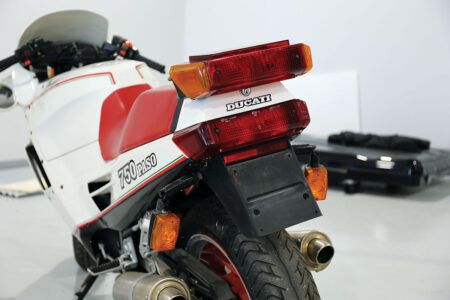Looking back at getting my 1988 Ducati Paso on the road, a big surprise was how much I didn’t have to do. A vintage Ducati sitting untouched for almost 20 years? What could go wrong?
Everything, of course. Yet amazingly, the Paso really didn’t require any more than your average Honda to put back to road duty. The needed repairs were mostly routine, and included timing belts, front fork seals, front and rear brake master cylinders, rear wheel bearings, tires, drive chain, a new battery, spark plugs, air and oil filters, and oil. And lots of carb work. More on that later.
I ordered parts as I could from known sources. Timing belts — along with invaluable tips — came from Steve Allen at bevelheaven.com, as did front and rear brake master cylinders, Brembo brake line crush washers, a rear brake light switch and a replacement cap for the clutch master cylinder. Some parts came from eBay, including FAG wheel bearings and Japanese-made fork seals, plus a few hard-to-find bits like an OEM choke lever and a complete rear swingarm, cheap at $40 and needed only for the half-moon axle clamps, no longer available from Ducati — or anyone else. On that choke lever, Stein-Dinse lists several alternatives, but apparently I chose wrong, as the lever I got didn’t match with the choke cable. Stein-Dinse also had the stock Weber throttle and choke cables, air filter, and various rubber bits I needed including tank grommets for the side covers, the rubber stop for the center stand, and grommets and bushings for the muffler supports. Shinko SR880 front and SR881 rear tires came from Chaparral, and a used Euro-spec taillight assembly incorporating the signal lights took care of the always broken and unobtainable stalk-mounted U.S. market originals.
The previous owner ditched the center stand when he installed SuperTrapp mufflers, but fortunately Ed Milich at ducpower.com had a used one in stock, complete with springs and bushings. A quick date with the bead blaster and some paint, and it was good to go. Probably the hardest thing to find was a good set of mufflers. Scot Wilson at italianiron.com went to great pains trying to source me a clean set of the correct OEM Silentiums, but then I came across a pair of brand new, black chrome Silentium mufflers straight from Italy, via eBay. Claimed to be for the 750 Paso, they’re actually of the style used on the 907ie, and an almost perfect fit. Almost because securing them required using 907ie muffler brackets, but reversed; the left on the right, and vice-versa. Odd. Bottom line, while not strictly correct, they look excellent and sound great, if a little muted, a common criticism in the day.
Carburetion loomed as the biggest stumbling block to completion. I really wanted to run the original Weber and spent a lot of time overhauling the Paso’s. Yet it ran so badly once installed, I wasn’t sure where to start looking for a solution. It seemed like carburetion, but you know the old saw: 99 percent of all carburetor issues are electrical, and vice-versa. It stuck in my craw, because I know owners have tamed the Weber’s woes, and I was scratching my head wondering what I had missed or done wrong.

When I first fired it up last year, still on the Mikunis fitted by the previous owner because he had tired of the problematic Weber, I didn’t pay close attention to how it was running, because hey, it was running! It held an okay-ish idle, compression was great, and I naively assumed I’d get it properly dialed in later. It wasn’t until after I’d installed the Weber and it wouldn’t run properly, and then decided the Weber was the problem and swapped the Mikunis back again, that I realized it was only running on the rear cylinder. Some probing with a multimeter showed 10.2 volts to the ignition coils, and physical checks uncovered loose spade terminals at the Kokusan ignition triggers. Following those discoveries, I installed a 12-volt relay to provide power to the ignition straight from the battery, the key switch actuating the relay, then I replaced the spade terminals and pushed them fully home. It fired right up and ran beautifully on both cylinders. Hallelujah! Excited, I swapped the Weber back in, certain it would now run perfectly. No dice.
The Mikunis are back in, and the warm Autumn, along with what’s so far claimed to be winter, have given me ample opportunity to do what the Paso was made for, ride. But when the cold decides to stick around, I think I’ll have another go with the Weber. Until then, ride safe.
— Richard Backus/Founding Editor











